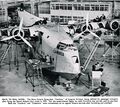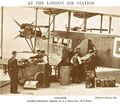Category:Imperial Airways: Difference between revisions
(+image) |
No edit summary |
||
| Line 1: | Line 1: | ||
{{Box|Wonder_Book_of_Aircraft,_Imperial_Airways_(WBoA_6ed_1928).jpg|'''1928:''' cover of the Wonder Book pf Aircraft, 6th edition|380}} | |||
{{Box|Family_scene,_Imperial_Airways_(PowerSpeed_1938).jpg|'''1938:''' Of its time: A posed publicity photo showing a family scene onboard an Empire Flying Boat|380}} | {{Box|Family_scene,_Imperial_Airways_(PowerSpeed_1938).jpg|'''1938:''' Of its time: A posed publicity photo showing a family scene onboard an Empire Flying Boat|380}} | ||
{{Box|Passenger_Luggage,_Croydon_(WBoA_6ed_1928).jpg|1928: Passenger Luggage being stowed, at Croydon|380}} | |||
With the grouping of Britain's railways in 1923 to produce the "[[Big Four]]" now out of the way, in 1924 the government was able to turn its attention to finishing the similar project for Britain's air transport companies, to form '''Imperial Airways'''. | With the grouping of Britain's railways in 1923 to produce the "[[Big Four]]" now out of the way, in 1924 the government was able to turn its attention to finishing the similar project for Britain's air transport companies, to form '''Imperial Airways'''. | ||
Revision as of 17:17, 28 February 2023
1928: cover of the Wonder Book pf Aircraft, 6th edition [image info]
1938: Of its time: A posed publicity photo showing a family scene onboard an Empire Flying Boat [image info]
1928: Passenger Luggage being stowed, at Croydon [image info]
With the grouping of Britain's railways in 1923 to produce the "Big Four" now out of the way, in 1924 the government was able to turn its attention to finishing the similar project for Britain's air transport companies, to form Imperial Airways.
Background
The rapid development of large long-distance aircraft (especially large seaplanes) was driving a similarly-rapid growth of long-distance air travel and air mail delivery services. Britain found itself trying to run an Empire that was increasingly dependent on strategic air routes. Since some of these were only marginally profitable and others were subsidised by foreign powers, this threatened to make British international communications dependent on foreign companies whose allegiances were ultimately not to Britain. What was needed was a similarly strategic outlook (and appropriate subsidisation) of British international air services.
By 1924, the position had become so serious that the government appointed a committee (later known as the Hambling Committee) to report on the methods of putting British Air Transport on a sound footing. This committee recommended that if British Air Transport were to survive, let alone develop, then one company and one alone must be entrusted with the task. This report led to the formation of Imperial Airways on March the 31st 1924 as the chosen instrument of the government with the mandate to develop British Air Transport on an economic basis.
— , -, , Aerial Milestones, Imperial Airways 1924 to 1939, Britain Contribution to Air Transport,
The one goal that we have always set before Imperial Airways is that they should put their operations on a commercial basis and become self-supporting at the earliest possible moment. With that goal in view, the design and number of the Company's air fleet has never been interfered with by the Air Ministry. These matters have been left to the Company and its expert advisers and have been governed solely by principles of strict business economy. The result has been that, with a far smaller subsidy, the Company has now advanced towards an economic basis of operation far ahead of its Continental rivals.
— , Sir Phillip Sassoon, , Some aspects of the Policy of Imperial Airways, , 8th March 1934
The year 1924 is specially notable in the development of organized air transport in the British Empire, because the subsidized company Imperial Airways, Ltd., was formed then to amalgamate the four existing British air transport companies into a national body with a view to concentrating on Empire air services. Its foundation was an event of importance in the development of air travel, and in the first six years of its existence it established a record of efficiency, reliability and safety which was unsurpassed by any similar organization. The record has been well maintained, and considerable progress has been made in the extension of the Company's air routes throughout the Empire. …
— , M.J.B. Davy, , Interpretative History of Flight, , 1937
It is with regard to the latter that we are most concerned in this country. The aeroplane — and perhaps the airship — by providing rapid communication between the countries in the British Empire can render a service which is vital to progress. This probably represents the most profitable of all the uses to which the aeroplane may be put, because the distances are very great and the existing communications, in regard to speed, inadequate. The linking of these several countries by air represents a profound achievement because it is directed towards the solution of a major problem — that of unrestricted and rapid intercourse between the peoples of the world. When we reflect that the air services of the British Empire operate not within the frontiers of one country or the limits of one continent but traverse four continents and some thirty countries, the achievement obtains an even greater significance. The operation of such services presents many difficulties, arising from the acute nationalism which has developed in many countries during recent years; national prejudices resulting from the play of international politics have to be overcome and agreement with the various foreign governments secured. The state of the world to-day, and particularly Europe, is not conducive to the successful development of international air transport, and until the principle of freedom of the air — on the analogy of the earlier freedom of the seas – is conceded, the greatest use cannot be made of the power of flight. It is remarkable that so much has already been accomplished.
— , M.J.B. Davy, , Interpretative History of Flight, , 1937
1933 information
Some facts about Imperial Airways
- It serves three continents and twenty-two countries
- It operates two regular services a week from London to Cairo with weekly extensions from these right across India and Burma to Rangoon and through Africa to Cape Town. The India and Eastern Service will be extended from Rangoon to Singapore in December
- It operates regular daily services to Paris, Brussels and Cologne and during the summer to Basle and to Zürich and a week-end service to Le Touquet
- The route mileage operated by the company is over twelve thousand five hundred
- The company owns a fleet of forty air liners of a total horse power of sixty thousand
- This fleet flies over two million miles a year, which is more than eighty times round the world at the equator
- The Company carries nearly a quarter of a million letters a week on its various services
- The Company employs on its staff over fourteen different nationalities excluding numbers of African and Asiatic natives
- The Company maintains bank accounts in ten currencies and has ledger accounts in twenty-five
- The Heracles class of air liners used between London and Paris are the largest and most comfortable in the world. They are so quiet that you can talk without raising your voice. They carry two stewards, who will serve you with table d'hôte or à la carte meals. There is ample luggage accommodation on board and two lavatories.
— , Imperial Airways, , The Chairman of Imperial Airways said ..., , 1933
External links
Subcategories
This category has the following 8 subcategories, out of 8 total.
A
- Armstrong Whitworth Argosy (2 P, 4 F)
- Atalanta (Armstrong Whitworth) (5 P, 10 F)
C
- Croydon Airport (17 F)
D
- De Havilland Express (2 P, 4 F)
H
- Handley Page HP42 Hannibal and Heracles (3 P, 10 F)
S
- Short S-17 Kent Flying Boat (empty)
- Short Scylla (empty)
Pages in category ‘Imperial Airways’
The following 11 pages are in this category, out of 11 total.
H
I
Media in category ‘Imperial Airways’
The following 34 files are in this category, out of 34 total.
- Armstrong Whitworth Argosy G-EBLF, leaving Croydon (WBoA 6ed 1928).jpg 3,000 × 2,202; 1.11 MB
- Armstrong Whitworth Argosy, Card No 03 (JPAeroplanes 1935).jpg 3,000 × 1,529; 660 KB
- Armstrong-Whitworth Ensign G-ADSR, Imperial Airways (PowerSpeed 1938).jpg 3,000 × 1,668; 1.15 MB
- Cambria, Short Empire Flying Boat (PowerSpeed 1938).jpg 3,000 × 2,668; 1.84 MB
- Canopus Empire Flying Boat G-ADHL, Imperial Airways (IHoF 1937).jpg 3,000 × 1,932; 1.37 MB
- Canopus Empire Flying Boat G-ADHL, on the Medway (PowerSpeed 1938).jpg 3,000 × 1,661; 1.08 MB
- Coriolanus, Empire Flying Boat G-AETV, Imperial Airways (PowerSpeed 1938).jpg 3,000 × 1,212; 595 KB
- Empire Flying Boat, Dinky Toys 60r (MeccanoCat 1939-40).jpg 1,181 × 882; 141 KB
- Empire Flying Boats, box lid (Dinky Toys 60r).jpg 2,429 × 3,000; 1.21 MB
- Ensign airliner G-ADSR, Imperial Airways (PowerSpeed 1938).jpg 3,000 × 1,423; 896 KB
- Entrance Hall, London Air Station, Croydon (WBoA 6ed 1928).jpg 3,000 × 2,494; 1.55 MB
- Family scene, Imperial Airways (PowerSpeed 1938).jpg 2,051 × 3,000; 1 MB
- Handley Page 42, Card No 31 (GPAviation 1938).jpg 2,400 × 1,254; 342 KB
- Handley Page Hannibal G-AAGX, Imperial Airways (MM 1931-04).jpg 3,000 × 2,176; 973 KB
- Handley Page Hannibal G-AAGX, side view, Imperial Airways (MM 1931-04).jpg 3,000 × 1,406; 920 KB
- Handley Page Heracles, Card No 14 (JPAeroplanes 1935).jpg 3,000 × 1,529; 606 KB
- Hanno, HP-42 Heracles-Class G-AAUD (WBoA 8ed 1934).jpg 3,000 × 2,212; 927 KB
- Helena, HP-42 Heracles-Class G-AAXF (WBoA 8ed 1934).jpg 3,000 × 1,966; 796 KB
- Hengist, HP-42 Heracles-Class airliner G-AAXE, Imperial Airways (WBoA 8ed 1934).jpg 3,000 × 2,173; 986 KB
- Hengist, HP-42 Heracles-Class G-AAXE (WBoA 8ed 1934).jpg 3,000 × 2,321; 1.08 MB
- Heracles biplane airliner G-AAXC.jpg 1,800 × 1,200; 1,023 KB
- Hercules DH-66 biplane, Imperial Airways (WBoA 6ed 1928).jpg 3,000 × 1,530; 1,020 KB
- Imperial Airways Frobisher Class Liner, Dinky Toys 62w (MM 1940-07).jpg 2,310 × 1,812; 316 KB
- Mayo Composite Aircraft, box lid (Dinky Toys 63).jpg 2,969 × 3,000; 1.69 MB
- Mayo Composite Aircraft, box lid artwork (Dinky Toys No63).jpg 2,770 × 3,000; 762 KB
- Mayo Composite Aircraft, Dinky Toys 63 (MCat 1939).jpg 1,444 × 878; 122 KB
- Mayo Composite Aircraft, Dinky Toys 63 (MM 1940-07).jpg 2,168 × 2,008; 423 KB
- Mayo Composite and Fairey Sea Fox at Felixstowe (PowerSpeed 1938).jpg 3,000 × 1,421; 919 KB
- Mayo Composite, side view (PowerSpeed 1938).jpg 3,000 × 1,540; 930 KB
- MM-Section Air News 2.jpg 2,182 × 711; 535 KB
- Passenger Luggage, Croydon (WBoA 6ed 1928).jpg 3,000 × 2,593; 1.55 MB
- Passengers boarding an Armstrong Whitworth Argosy G-EBOZ at Croydon (WBoA 6ed 1928).jpg 3,000 × 1,950; 955 KB
- Short-Mayo Composite Aircraft, jigsaw (Victory MA2).jpg 3,000 × 2,336; 1.88 MB
- Wonder Book of Aircraft, Imperial Airways (WBoA 6ed 1928).jpg 2,253 × 3,000; 1.78 MB





































